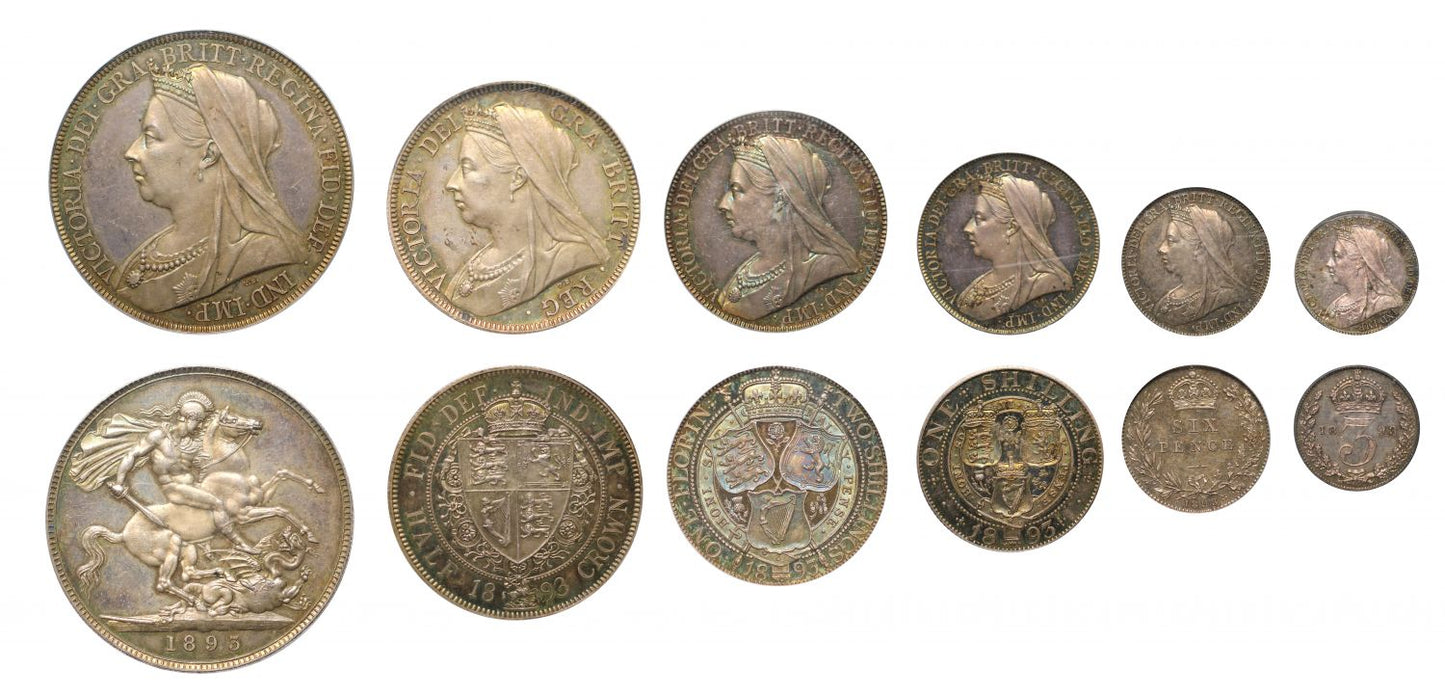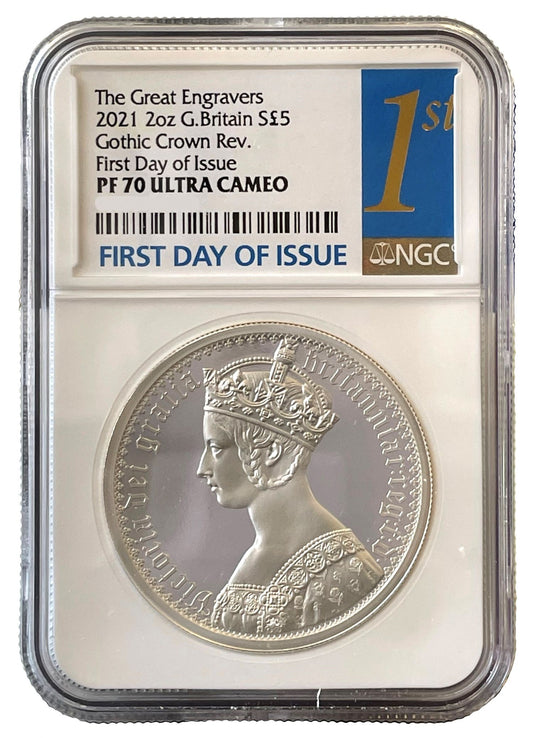FAQs
What makes a coin valuable?
I have coins to sell, what’s the next step?
How will my purchases be shipped?
What happens if I’m not entirely happy with my purchase?
Victoria 1893 6-coin silver proof Set PR62-PR65
Victoria (1837-1901), silver Proof set (6), 1893, proof silver Crown, Halfcrown, Florin, Shilling, Sixpence and Threepence, older crowned and veiled bust left, T.B. initials below truncation for designer Thomas Brock, Latin legend and toothed border surrounding, rev. Crown with St George and dragon right, date in exergue, Halfcrown with crowned quartered spade shaped shield of arms, within Order of the Garter, date at bottom, legend surrounding, Florin with crown over three emblematic shields over crossed sceptres, emblems and garter with outer legend surrounding, Shilling with individual crowned emblematic shields, with emblems and garter around, outer legend surrounding, Sixpence with crowned mark of value in words within wreath, date below, Threepence with crowned mark of value within wreath, date either side of 3 (S.PS8; Crown Bull 2594, ESC 304, L&S 109, Davies 501, S.3937; Halfcrown Bull 2779, ESC 727, Davies 663, S.3938; Florin Bull 2963, ESC 877, Davies 831 dies 2+A, S.3939; Shilling Bull 3155, ESC 1362, Davies 1011 dies 2+A, S.3940; Sixpence Bull 3286, ESC 1763, Davies 1181 2+A, S3941; Threepence Bull 3445, ESC 2105, Davies 1350 dies 1+A, S.3942). All with attractive dark tone, all graded and slabbed by PCGS as below.
PCGS Certification:
Crown PR64 Cameo 389151.64/19005856
Halfcrown PR64 Cameo 389150.64/19005855
Florin PR64 Cameo 388587.64/19005854
Shilling PR65 Cameo 389149.65/19005853
Sixpence PR63 204988.63/19005852
Threepence PR62 204619.62/19005851
The silver proof sets of the new coinage were sold in small quantities though were more popular than the Boehm design of 1887 with the actual number sold at 556 sets, and not all of them would have opted to have the deluxe fitted case there is no case with this set..
The new coinage of 1893 was by all accounts immediately well received, the direct result of the apparent ineptitude of the Jubilee series placed the fresh designs in good stead. In the Spink monthly numismatic circular of March 1893 there contains an article by Max Pemberton which summarises the mood at the time. "-the humorously hideous Jubilee coins is now nigh forgotten - the obverse of all the new coins will bear the new head of her majesty which Mr Brock has designed. It is as you may see, an infinitely artistic thing." There are several other quotes which on the whole can be interpreted or framed into two schools of the thought, a) these older bust portrait coins executed by Thomas Brock and Mr Poynter are genuinely innovative, stylish and well executed and b) the new coinage was seen as a much-needed change to then disliked Jubilee series. The Queen with coronet and lace veil were particularly appealing, some of the Silver pieces were subject however to a myopic scrutiny relating to the amount of words in the legends and accusations of "ill balance" and a "want for rotundity" were put forward. One must consider, these were criticisms of the day and were role specific to a certain point in time, also the new coinage of 1893 would have still been set side by side with other older Hanoverian coins and Latin legend standards. All in all, the 1893 series was a huge success then, as it is now.
The 6-coin Proof set, as is the case with all the Royal mint gold and silver Proof assemblages follows a display of the denominations, from large to diminutive, from silver Crown to Threepence. The Crown with the Pistrucci reverse die, the other pieces with armorial and imperial Heraldic designs fastened and connected to the United Kingdom. Quintessential late Victoriana.
The Royal Mint annual report of 1894, volume 25 (p.33-34) outlines some interesting information on the volume and the way in which these proof sets (referred to as Specimen coins) were struck. Specially prepared specimens of the 1893 new coinage began to be prepared in September of 1893 - brought to a halt in 1894. In accordance with their lordships directions the following statistical data is at hand as a primary reference point, for these sets.
Complete sets of gold and silver coins: 756
Sets of Gold coins : 17
Sets of Silver : 556
In today's market the older head Brock portrait coinage does hold a premium, they are always it seems in great demand especially when Proof struck types or sets, the price guides also reflect this; especially with the Five Pound pieces whether currency or Proof, an 1893 is considerably more difficult to procure than an 1887 Five-pound coin.
Biographical note:
Sir Thomas Brock (1847-1922), sculptor. KCB Royal academy 1891. In 1891 commissioned to design the new effigy of Victoria, what became known as the old-veiled bust, a numismatic sea change to Boehm's small crown tiara Jubilee series. Brock received several plaudits, the Times newspaper on 31st January 1893 had stated "the likeness is good [Queen Victoria] and as was to be expected from so scholarly a sculptor as Mr Brock, the modelling is excellent." He also went on to design the diamond Jubilee medal of 1897. The Pall Mall gazette, 20th April 1892, also records that Brock and Edward Poynter were the successful winners in the competition to design the new coinage (ie; the old head coinage of 1893-1901).
FAQs
What makes a coin valuable?
I have coins to sell, what’s the next step?
How will my purchases be shipped?
What happens if I’m not entirely happy with my purchase?













